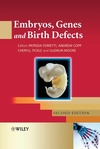The title is based on Professor Thorogood's successful Embryos, Genes
and Birth Defects. The new edition is completely revised and updated
to reflect the latest development in the field. It features new
chapters on human cytogenetics, mutagenesis and the eyes and ears.
The chapters on specific organs will follow the format adopted in the
first edition, covering developmental anatomy, the main classes of
defects, cellular and molecular mechanisms affecting development and
how they contribute to elucidate the causes of abnormal development,
and an agenda for the future.
The chapter on mapping syndromes to genes has been combined with that
on dysmorphology databases, reflecting the increased use of genomics
and bioinformatics in such studies.
Preface.
1 The Relationship between Genotype and Phenotype: Some Basic
Concepts Philip Stanier and Gudrun Moore.
Introduction.
The relationship between genotype and phenotype.
The role of 몀odel systems?
The changing concept of homology.
2 Uses of Databases in Dysmorphology Michael Baraitser.
What is a syndrome?.
Some of these problems are addressed by dysmorphology databases.
Where databases do not help.
Dysmorphology databases.
How databases work.
3 Human Cytogenetics J. D. A. Delhanty.
Introduction.
Population cytogenetics.
Structural anomalies.
The genesis of chromosome abnormalities.
Embryo survival.
The cause of high levels of chromosome abnormality in human embryos.
Relative parental risks ?age, translocations, inversions, gonadal
and germinal mosaics.
4 Identification and Analysis of Genes Involved in Congenital
Malformation Syndromes Peter J. Scambler.
Gene identification.
Biological analysis of genes implicated in birth defect syndromes.
Animal models.
Why study rare human birth defect syndromes?.
5 Transgenic Technology and Its Role in Understanding Normal and
Abnormal Mammalian Development Valerie Vidal and Andreas Schedl.
Introduction.
Transgenic mice.
Genetic manipulation using gene targeting in ES cells.
Outlook and future developments.
6 Chemical Teratogens: Hazards, Tools and Clues Nigel A. Brown (with
revisions by Cheryll Tickle).
Introduction.
Teratogens and human malformations.
General strategy in chemical teratogenesis.
Valproic acid.
Gene뻯eratogen interaction.
Teratogens and phenocopies.
Teratogens as manipulative tools.
Teratogens as clues.
Final comments.
7 The Limbs Patrizia Ferretti and Cheryll Tickle.
Developmental anatomy of the human limb.
Main classes of limb defects.
Contemporary studies on mechanisms of limb development.
Limb regeneration.
How, when and where experimental studies elucidate abnormal
development.
Agenda for the future.
8 Brain and Spinal Cord Andrew J. Copp.
Introduction.
Overview of nervous system development.
Defects of CNS development: towards a genetic and developmental
understanding.
Agenda for the future.
9 Birth Defects Affecting the Eye Jane C. Sowden.
The eye.
Development of the eye.
Congenital eye defects and paediatric blindness.
Gene mutations underlying congenital eye defects.
Cellular and molecular mechanisms affecting eye development and how
they elucidate the causes of abnormal development.
Agenda for the future.
10 The Ear Sarah Spiden and Karen P. Steel.
Introduction.
Development of the outer and middle ear.
Development of the inner ear.
Main classes of ear defects.
Mechanisms involved in development of the outer and middle ear.
Mechanisms underlying inner ear development.
Mechanisms underlying development of inner ear sensory epithelia.
Mechanisms involved in endolymph homeostasis.
The future.
11 Development of the Enteric Nervous System in Relation to
Hirschsprung뭩 Disease Heather M. Young, Donald F. Newgreen


